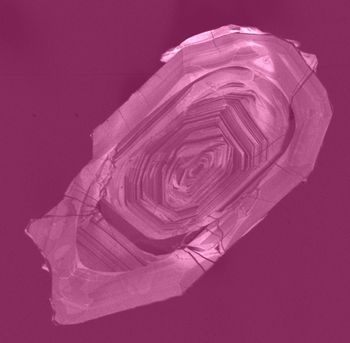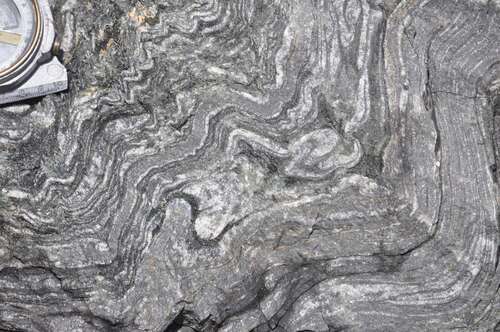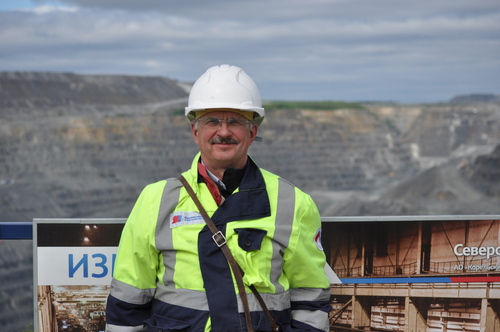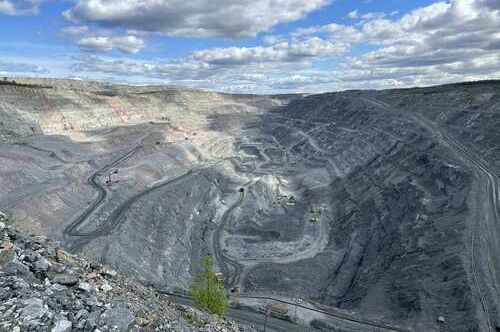– BIFs are not supposed to contain zircons, but its grains may have been introduced from other host rocks. Our Karelian quartzites proved to be unusual: they are quite abundant in zircons, which are much less common in similar rocks elsewhere in the world, – told Alexander Slabunov, Head of the Precambrian Geology and Geodynamics Laboratory, Institute of Geology KarRC RAS.

Longitudinal section of a zircon crystal in cathode rays.
Its size is about 150 µm (1 µm = 0.001 mm, a human hair is about 50 µm).
This zircon grain is aged 2.73 billion years
Zircon (ZrSiO4) is a mineral with properties that make it a unique source of information on the age and genetic environment of the host rock.
Previously, Karelian scientists have distinguished three types of banded iron formations within the Kostomuksha deposit. Latest techniques and methods have now enabled researchers to specify their age and the settings in which they were formed. The oldest layer with BIF-1 appeared 2.87-2.84 Ga BP. For now, it is of the least interest for the economy, having the lowest iron content, but it is of great interest for basic science, helping us learn more about the early history of the Earth.
Three billion years ago, the Earth's atmosphere consisted of carbon dioxide and virtually no oxygen, which means there was no oxygen in oceanic water either. At the same time, ocean waters received plenty of iron from hydrothermal sources - "black smokers". There being no oxygen, this iron was dissolved in the water. In some places in the ocean, however, it did get oxidized (such areas are called "oxygen oases") and deposited to the bottom in the form of thin rust-like layers. Scientists assume that the source of oxygen in these oases was cyanobacteria.
– BIFs are one hundred percent a product of the oddity of our planet early in its history. The atmosphere as we know it doesn't exist yet, but there are already oxygen-producing living creatures in the water, – the research leader remarked.
BIFs are spectacular rocks with a fine-banded structure. The layers alternate repeatedly: some are dominated by white quartz, others by silvery gray magnetite. Apparently, cyanobacteria accumulated oxygen until its concentration reached a certain level, after which iron was bound and precipitated in the form of rust, from which magnetite was later formed. Then again, silica gel was precipitated, from which quartz was formed. Thus, these rocks are unique not only because they provide iron to be used in industry, but also because they act as a record of a peculiar era in the planet's development.
The ore of the second type (BIF-2) is 2.8 billion years old, and the youngest type BIF-3 is aged 2.76–2.74 Ga.
– During this period, our Karelia was more like Kamchatka, where subduction - dipping of the oceanic plate under the edge of the newly formed continent - was taking place. A chain of volcanoes passed through Kostomuksha 2.8 billion years ago, next to which there was a sea basin in which "black smokers" were simmering, cyanobacteria resided, and iron was accumulating. This is when the richest ores (BIF-3) were formed, – Alexander Slabunov told.

Folded – deformed – BIF-3 of the Kostomuksha deposit.
They consist of alternating quartz-enriched white bands and magnetite-enriched gray bands.
The object in the upper left corner is a mountain compass, which, however, points north incorrectly in locations with iron ore
Having analyzed the zircons, we managed not only to establish the depositional age of all the BIF types, but also to decipher the history of their subsequent metamorphoses. For the industry, the fact of ore transformation is extremely important: according to practicing geologists, metamorphosed ores are easier to enrich and therefore more valuable.
The experience, competencies and equipment available at KarRC RAS enable the scientists to find the necessary samples in the field and then, in the laboratory, to determine their chemical and mineral composition, and to date the rocks.
– If our hypothesis that multiple transformations result in an improved ore quality proves correct, we’ll be able to suggest a technique for spotting areas with the most valuable ore, – the expert explained about the practical application of the data.
The studies are carried out within a project funded by Russian Science Foundation grant # 22-17-00026, where the Leader is Alexander Slabunov. As a result, new information about the structure and composition of the main iron ore body of the largest iron deposit in Northwest Russia and new knowledge about early Earth geodynamics will be obtained. The results of the project will enrich the global scientific knowledge of what the planet was like billions of years ago.
– How well we understand the early history of our planet predicates our ability to predict its future, – the scientist summed up.
The scientists thank the managers and employees of Karelsky Okatysh JSC (Kostomuksha) mine administration for their multifaceted assistance in carrying out geological research at their pits.






